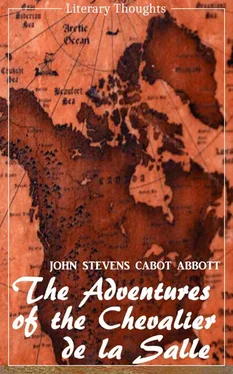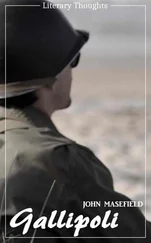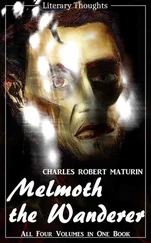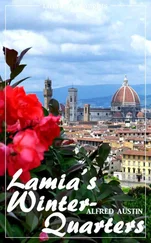Then, turning to a little Indian captive boy, at his side, whom they had taken from some hostile tribe, and had adopted into the family of the chief, he added:
"Here is my son. I give him to you that you may know my heart. I implore you to take pity upon me, and upon all my nation. Thou knowest the Great Spirit who has made us all. Thou speakest to Him and hearest His word. Ask Him to give me life and health, and to come and dwell with us, that we may know Him."
He then led the little captive to the side of M. Marquette. This was in return for the first present. Holding in his hand a calumet very highly carved and ornamented with feathers, he presented it to the father, saying:
"This is the sacred calumet. It signifies that, wherever you bear it, you are the messengers of peace. All our tribes will respect it, and will protect you from every harm."
The bowl of the pipe was of some highly polished red stone. The stem, elaborately decorated, was of a reed about two feet long. "By this present," said he, "we wish to show our esteem for your chief, whom we must all revere after the account you have given us of him." The third and fourth presents consisted, so far as we can judge from the rather obscure narrative, of two thick mats, one for each of the guests, to serve them for beds on their voyage. At the same time the chief said:
"I beg of you, in behalf of the whole nation, not to go any farther down the river. Your lives will be in the greatest peril.
"I replied," Father Marquette writes, "that I did not fear death, and that I esteemed no happiness greater than that of losing my life for the glory of God, who made us all. But this, these poor people could not understand."
The council now broke up, and a great feast was given. It consisted of four courses. The first much resembled what is called in New England hasty pudding. It consisted of Indian meal, and corn pounded fine, and boiled in an earthen pot, and was eaten with melted fat. The master of ceremonies took some on a wooden plate, and with a horn spoon, quite neatly made, fed the two Frenchmen as a mother feeds a child.
The second course consisted of three boiled fishes. Carefully the bones were removed, and the Indian who served them placed the food in the mouths of their guests as before. He blew upon it, to be sure that it was sufficiently cool. For the third course there was brought forward a large baked dog. This was considered a great delicacy, and was deemed the highest compliment which could be shown to a guest. But the prejudices of the Frenchmen were such that they could not eat dog, and this dish was removed. The fourth course consisted of fat and tender cuts of buffalo meat. This also was placed in their mouths as parents feed a child.
There were three hundred wigwams in the village. After the feast the guests were led into each one of them, and introduced to the inmates. As they walked through the streets a large crowd accompanied them. Some men, officiating as a kind of police, were continually haranguing the throng, urging the people not to press too close, and not to be troublesome. Many presents were made them of belts and scarfs woven from hair and fur, and other small articles of Indian manufacture, brilliantly colored and richly embroidered with shells. They had also knee-bands and wrist-bands which were quite ornamental.
That night the guests slept in the wigwam of the chief. The next morning they took leave of their generous entertainers. The chief himself accompanied them to their canoes, followed by a retinue of nearly six hundred persons.
We cannot record this friendly reception without emotion. How beautiful is peace! How different would the history of this world have been but for man's inhumanity to man!
CHAPTER II. – The First Exploration of the Mississippi River.
River Scenery. The Missouri. Its Distant Banks. The Mosquito Pest. Meeting the Indians. Influence of the Calumet. The Arkansas River. A Friendly Greeting. Scenes in the Village. Civilization of the Southern Tribes. Domestic Habits. Fear of the Spaniards. The Return Voyage.
Father Marquette and M. Joliet had astronomical instruments with which they ascertained, with much accuracy, the latitude of all their important stopping places. As they state that the two villages, which they visited, were on the western side of the Mississippi, at the latitude of forty degrees north, and upon the banks of a stream flowing into the Great River, it is supposed that these villages were upon the stream now called Des Moines, which forms a part of the boundary between Iowa and Missouri. The Indians called the villages Pe-ou-a-sea and Moing-wena. They were probably situated about six miles above the present city of Keokuk.
It was three o'clock in the afternoon, of a day near the end of sunny, blooming June, when our voyagers resumed their adventurous tour. Nearly the whole tribe they had visited stood upon the bank to bid them adieu. They floated along through a very dreary country of precipitous rocks and jagged cliffs, which quite shut out from their view the magnificent prairie region which was spread out beyond this barrier.
Upon the smooth surface of one of these rocks, apparently inaccessible, they saw, with surprise, two figures painted in very brilliant colors and with truly artistic outline. They thought that the painting would have done honor to any European artist. The figures were of two rather frightful looking monsters, about the size of a calf, in red, green, and black. Stoddard, in his history of Louisiana, says that these painted monsters, between the Missouri and the Illinois Rivers, still remain in a good degree of preservation.
"As we were discoursing of them," writes Father Marquette, "sailing gently down a beautiful, still, clear water, we heard the noise of a rapid, into which we were about to fall. I have seen nothing more frightful. A mass of large trees, entire, with branches, real floating islands, came rushing from the mouth of the river Pekitunoüì, so impetuously that we could not, without great danger, expose ourselves to pass across. The agitation was so great that the water was all muddy, and could not get clear."
This was the rush and the roar of the incoming billows of the terrible Missouri, the most tremendous river upon this globe. It enters the Mississippi through a channel half a mile in breadth, rushing down with a sort of maniacal fury, from its sources among the Rocky Mountains at the distance of three thousand and ninety-six miles. Its whole course, from its rise to its entrance into the Gulf of Mexico, is four thousand three hundred and forty-nine miles. More than two hundred and fifty years after this, Mr. George Catlin ascended this river in the first steamer which ever ventured to breast its torrent.
It took the steamer three months to ascend to the mouth of the Yellowstone, two thousand miles from the city of St. Louis. At this point the American Fur Company had erected a very substantial fort, three hundred feet square, for the protection of their property against the savages. The banks of the stream were lined with the villages of the Indians. Their wigwams were of a great variety of structure. The scenes presented were astonishing in their wild and picturesque aspect. Crowds of weird-like savages would often be collected on the bluffs, watching the appalling phenomenon of the passing steamer.
The Missouri is different, perhaps, from any other river in the world. Its boiling, turbid waters rush impetuously on, in an unceasing current, for hundreds of leagues, with scarcely a cove, an eddy, or any resting place where a canoe can be tranquilly moored. The Indian name of the river signifies Muddy Water. It is so opaque, like a cup of chocolate, that a newly coined shilling, placed in a tumbler, cannot be seen through the eighth part of an inch of the water.
Читать дальше












